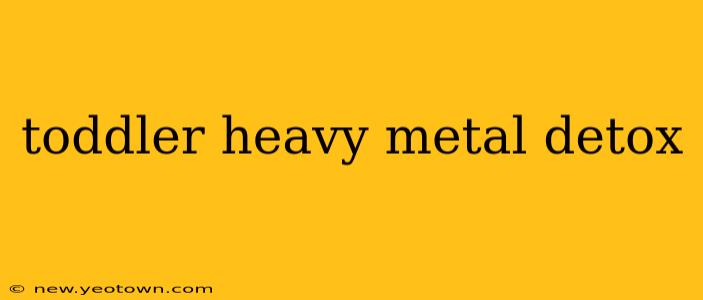Toddler Heavy Metal Detox: A Parent's Guide to Protecting Your Little One
The thought of heavy metals in our children’s bodies is terrifying. It’s a modern-day parental fear, fueled by concerns about environmental contamination and the long-term health effects of toxins like lead, mercury, and arsenic. While a complete avoidance of heavy metals is nearly impossible, understanding the risks and taking proactive steps to minimize exposure and support detoxification is crucial for every parent. This isn't about panic; it's about informed, loving care.
My journey began with a nagging worry. My son, Leo, was displaying some unusual symptoms – lethargy, irritability, and developmental delays that his pediatrician couldn't fully explain. After extensive testing, we discovered elevated levels of lead in his blood. The experience was jarring, but it also ignited a deep dive into the world of heavy metal detoxification in toddlers. What I learned transformed not only Leo's health but also my understanding of environmental hazards and the power of preventative measures. This guide shares what I’ve discovered, hoping to help other parents navigate this complex issue.
What are the common sources of heavy metal exposure in toddlers?
This is a crucial question because understanding the source is the first step towards prevention. Heavy metal exposure in toddlers can stem from various sources, including:
- Old paint: Homes built before 1978 may contain lead-based paint, which can chip and become a source of ingestion, especially for curious toddlers.
- Contaminated soil: Lead and other heavy metals can accumulate in soil, particularly near industrial areas or older homes. Toddlers often play in the dirt, leading to exposure through hand-to-mouth contact.
- Water: Lead can leach into drinking water from old pipes. Testing your water supply is essential.
- Certain foods: While less common, some foods can contain traces of heavy metals. Seafood, for instance, can have mercury.
- Toys and household items: Some older toys and household items may contain lead or other heavy metals.
What are the signs and symptoms of heavy metal toxicity in toddlers?
Recognizing the signs of heavy metal toxicity is essential for early intervention. While symptoms vary depending on the metal and the level of exposure, common signs include:
- Developmental delays: This can manifest as slow speech development, difficulty with motor skills, or cognitive impairments.
- Behavioral problems: Increased irritability, hyperactivity, or aggression.
- Gastrointestinal issues: Vomiting, diarrhea, or abdominal pain.
- Neurological symptoms: Headaches, dizziness, or seizures (in severe cases).
- Fatigue and lethargy: Persistent tiredness and lack of energy.
It's crucial to remember that these symptoms aren't unique to heavy metal toxicity. A thorough medical evaluation is necessary for accurate diagnosis.
How can I detoxify my toddler from heavy metals?
Detoxification in toddlers requires a multifaceted approach focusing on minimizing further exposure and supporting the body's natural elimination processes. This is not a quick fix; it's a journey that involves patience and consistency. Always consult with a pediatrician or a qualified healthcare professional before attempting any detoxification strategy.
Here are some commonly recommended approaches:
- Dietary changes: Focus on a diet rich in fruits, vegetables, and whole grains to support overall health and provide antioxidants that may aid in detoxification. Avoid processed foods and sugary drinks.
- Chelation therapy: This medically supervised approach uses specific medications to bind to heavy metals and help the body eliminate them. It's typically reserved for cases of significant heavy metal exposure.
- Supplements: Certain supplements, such as chlorella and zeolite, are believed to support heavy metal detoxification. However, their effectiveness is debated, and they should only be used under professional guidance.
- Environmental remediation: This involves identifying and addressing sources of heavy metal exposure in your home and environment. This might involve testing your water, removing lead-based paint, or improving soil quality.
What preventative measures can I take to protect my toddler from heavy metal exposure?
Prevention is always better than cure. Here are some crucial preventative measures:
- Regularly test your water: Ensure your drinking water is free from lead contamination.
- Dust and clean frequently: Regular cleaning can remove heavy metal particles from surfaces.
- Wash your child's hands frequently: This is especially important after playing outdoors.
- Choose safe toys and household items: Opt for toys and products made from non-toxic materials.
- Maintain a healthy diet: A balanced diet rich in fruits, vegetables, and whole grains supports overall health and detoxification.
Leo's journey wasn't easy, but it taught me the importance of vigilance and proactive care. By understanding the risks, minimizing exposure, and working closely with healthcare professionals, we significantly reduced his lead levels and saw remarkable improvements in his health. Remember, your child's well-being is paramount. Don't hesitate to seek professional help if you have concerns about heavy metal exposure. Your proactive approach can make a world of difference in your child’s life.

